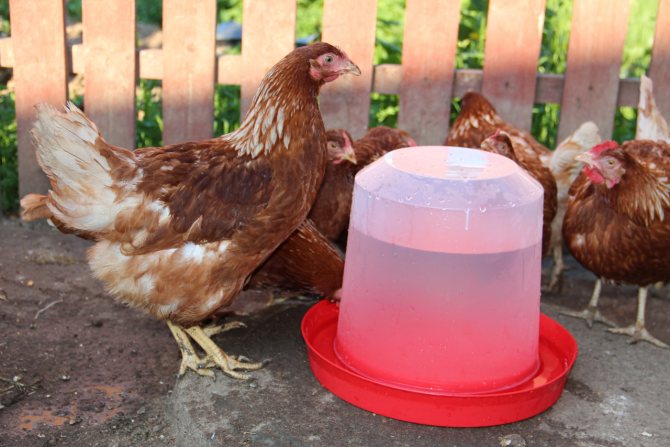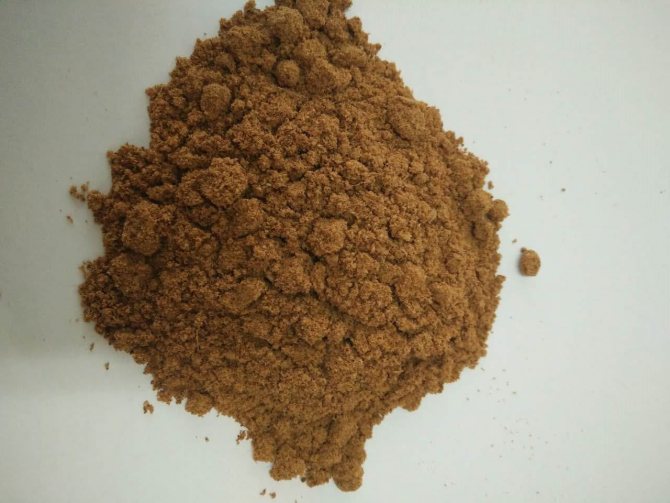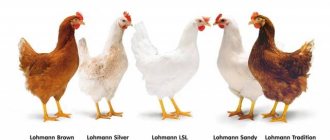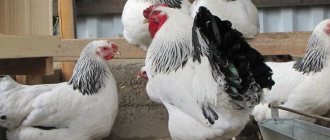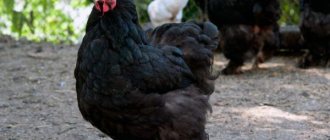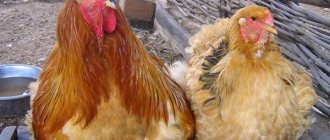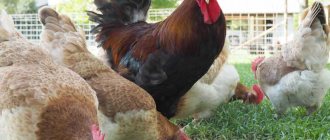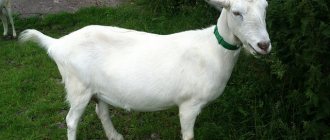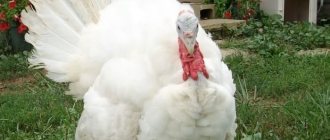The Dutch breed of chickens Hisex Brown is a productive cross of the egg direction, which is quite successfully inhabiting today domestic farmsteads. The history of this variety is not so long - only about 50 years, but it can be called glorious, because today these chickens are grown throughout the entire European territory, in the United States, Canada, on the Australian continent and in New Zealand, in the Russian Crimea, on Caucasus, Urals and Siberia.
Reviews of the hybrid variety can be found predominantly of a positive nature. Of course, she also has disadvantages, but they are lost against the background of numerous advantages. The main one is the high egg production, which is genetically inherent in crosses. But it can be negatively affected by external causes, for example, improper care and feeding, so it is important to know how to avoid possible mistakes in keeping poultry.
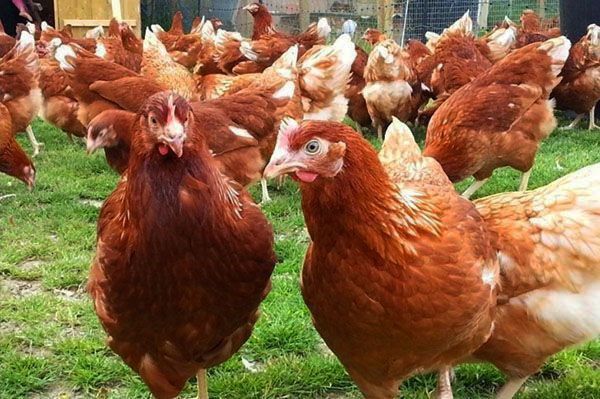
Chickens Hisex Brown
General characteristics
Highsex chickens have gained popularity in the poultry world for a number of reasons, among which are:
- high survival rate and unpretentiousness to living conditions - birds do not require special conditions for comfortable living and livelihoods;
- calm disposition and lack of aggression - chickens can live in a common hen house with other inhabitants;
- strong immunity - with properly organized maintenance, pets are not subject to most avian diseases;
- unpretentiousness in the diet - birds can even eat scraps from the owner's table;
- foraging - when walking, chickens are able to feed themselves on their own, finding food that contains the elements necessary for their health: vitamins, minerals, protein.
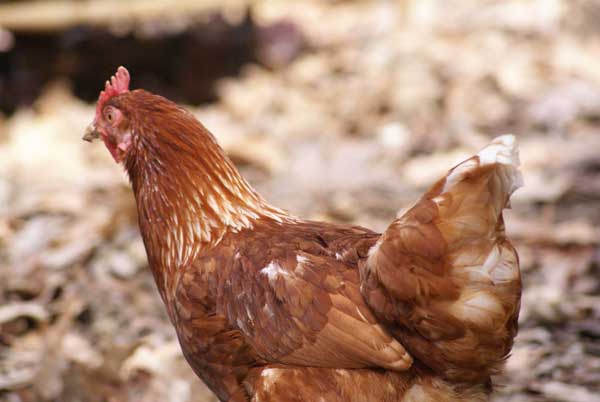

Highsex chickens are distinguished by complaisance, calm demeanor and perseverance.
How to feed the birds?
The preparation of a menu for chickens should be approached responsibly.
Chicks
Chickens Hisex Brown and White in the first few days of life must be fed with chopped boiled egg with the addition of finely chopped plants - sorrel, dandelion and nettle. From the 4th to 5th day of life, it is recommended to add fresh green onions to the main feed. This will help protect chicks from infectious diseases.
Subsequently, the following chicken menu is recommended:
- end of the first week: wheat and oatmeal, a mixture of corn flour with drinking water;
- from the second week: gradual addition of compound feed for chicks;
- third week: full transfer to mixed feed for young herd and a mixture of crushed grains.


In addition, it is necessary to give Hisex Brown chickens fresh greens and chopped vegetables, as well as special mineral and vitamin complexes. The water for the chicks must be changed twice a day. In order to prevent infections, a little potassium permanganate should be added to it.
See also
When chickens begin to lay at home and the duration of egg productionRead
Adult herd
Hisex Brown adults need a balanced diet of high quality. The best option would be ready-made feed for egg-bearing breeds. You can cook it yourself by mixing the following components in certain proportions:
- 3 parts corn;
- 3 parts wheat;
- 2 parts legumes;
- 1 part oats.
Additional ingredients are meat and bone meal, as well as fine gravel and river sand, which contribute to the better grinding of the grains in the poultry crop.


Fresh and boiled vegetables are also an essential part of the diet. In summer, cucumbers, zucchini, pumpkin, cabbage and any kind of greenery are suitable. In winter - boiled potatoes, as well as chopped peelings from them. It is recommended to introduce soybean meal into the diet, which is a source of vegetable protein. And flaxseed and sunflower meal replenish the deficit of fats in the body of chickens.
In the warm season, free-range chickens feed on fresh grass on their own, so the amount of feed should be reduced by 10-15%. In winter, hay can be fed to birds as a substitute for grass.
Two subspecies
The line of hybrid highsex chickens is presented in two varieties - brown (brown) and white (white).
Hisex brown, like its "white" counterpart, was bred in Holland. Breeding work began in 1968. The goal of breeding is to get healthy and hardy chickens that can reproduce eggs in mass quantities.
Scientists achieved the expected results in 2 years. After another 4 years, the chickens of the Dutch line came to the territory of the USSR. To this day, highsex holds a significant place among other egg crosses. They are in demand by small and large farmers and poultry breeders.
Consider a detailed description of each type of highsex chickens.


History
The Hisex breed first appeared in Holland in 1970 as a result of the crossing of two well-known species - the egg Italian “Leghorn"And American meat breed"New Hampshire“, Which is also a cross. The resulting hybrid allowed a significant increase in egg production, making these layers very popular with egg farmers.
The breeding process took only two years, but this time was enough to bring out one of the most popular types of chickens of the egg type today. In the countries of the former CIS, the history of the popularity of Hisex began in Ukraine, where a batch of poultry was purchased by one of the poultry farms as an experimental one. Subsequently, thanks to the impressive egg productivity, these layers became widespread, becoming permanent residents of egg poultry farms, even in the harsh Siberia.
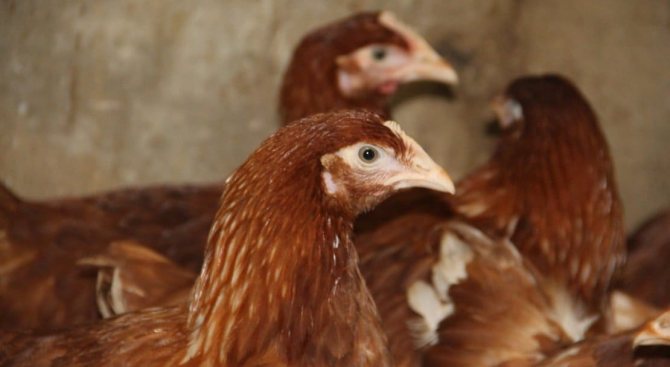

Haysex brown
general information
Highsex brown chickens have a slender build. The color of the feathers is often bright brown. Feather tips may have dark brown or white spots.
Because of this color, the plumage of brown highsex is often confused with rhodonite chickens, the full description of which is given in the article "Rhodonite breed of chickens".
It is believed that the highsex brown cross was obtained using the genetic material of New Hampshire chickens, which also have brown feathers.
The plumage of highsex brown is dense. The scallop is massive and erect, bright red in color. Paws are yellow, set wide apart. The head and beak are medium in size.


Productive qualities
A highsex brown chicken reaches a weight of up to 2.5 kilograms, a rooster - from 2.8 to 3 kilograms. The meat of the birds is tough, both in young and older individuals.
Chickens have good productivity. The highsex brown laying hen gives up to 336 eggs per year, therefore the highsex brown line is referred to as the egg type. The eggshell is porous, the color is cream or white, the weight can reach 70 grams.
Highsex brown becomes sexually mature by 5-6 months of age. Chickens have a high egg production from the second to the third year of life, then the egg production falls. Roosters are fertile for 5 years.
Productivity
An adult Hisex Brown laying hen, under the right conditions, reaches sexual maturity at the twentieth week. From that moment on, she is able to produce eggs almost daily. This is the most valuable quality of the cross, for which it is appreciated by individual breeders and industrial poultry farms.
Farmers note that from a healthy laying hen it is very rare that one obligatory egg per day is missing. The average is considered to be at least 90 eggs per 100 days. Moreover, each weighs at least 70 grams, which puts the eggs in the highest category. The shell is quite strong and brown in color.
The meat value of birds is much more modest. An adult chicken rarely weighs more than 2.3 kilograms. A rooster, with a properly formulated diet, sometimes reaches a record figure of 3 kg, but usually stops at 2.6 kg.
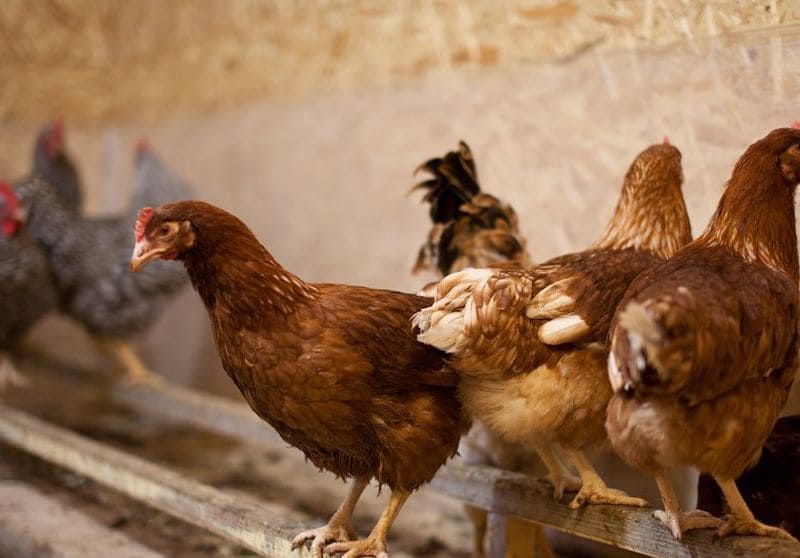

Haysex white
Highsex chickens with white plumage have “white” instead of the prefix “brown” in the name.
In addition to the color of the feathers, there are no significant differences from another variety of highsex white chickens.
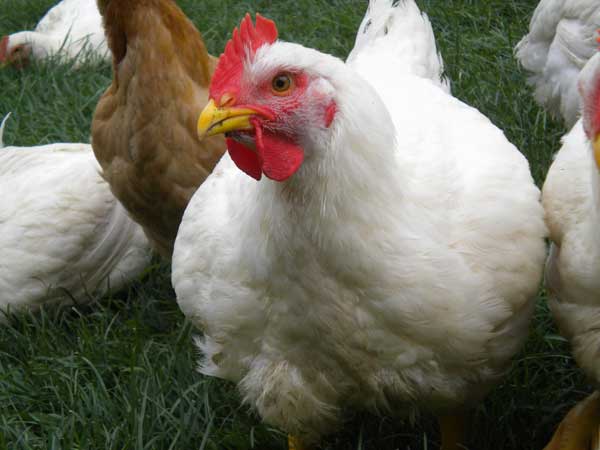

It is believed that brown chickens fly better than highsex white. Interesting information on this topic can be found in the article "Which chickens fly better: white or red?"
Features of the content
Representatives of the highsex line stand out for their simplicity in content.
Chickens are not demanding on space in the room, modest and calm neighbors. Living in an area with chickens of other breeds and species with a similar temperament is permissible. It is recommended to keep away from aggressive birds.
Dry straw or hay, cattle manure, fallen leaves, peat, fine sand can be used as bedding on the floor of the chicken coop.
Chickens can live at a room temperature of at least +12 degrees. Resistant to sudden changes in temperature.
In winter, the room must be illuminated for at least 12 hours. And then there will be no break in egg production for the winter period in highsex chickens.
How to grow
We will learn important points on the maintenance and care of Hisex Brown chickens.
So, although this breed does not differ in particular whimsicality, nevertheless, the creation of favorable conditions for it is highly desirable: it is beneficial, first of all, to the breeder himself. When constructing a chicken coop for Hisex Brown, it is necessary to proceed from the fact that 4 adult birds can be located on one m2 of area without prejudice to the well-being and health of each other.
In general, chickens do not require compliance with any special temperature conditions; there is no need to monitor the humidity of the air. Still, this breed will feel better in a dry room than in a humid one.
Birds can feel great both in a warm and in a fairly cool room. However, the temperature in the hen house should not drop below +12 degrees: this is the limit beyond which the bird will already be uncomfortable.
But what reviews there are about the Tsarskoye Selo breed of chickens, and how the breeding of this breed occurs, is detailed in this article.
In the video - how to raise Hisex Brown chickens:
For the winter in our climate, the chicken coop must be insulated or artificially heated. In addition, it is important that the paws of the chickens are always on a thick bed of dry straw during the winter.
The room for keeping chickens must be well ventilated. However, birds do not like drafts, therefore, when ventilating, you need to make sure that the bird is comfortable.
Young birds and chickens are less tolerant of the cold, so they can be kept in a separate, warmer room. It is generally desirable for chickens to provide a round-the-clock temperature of +22 degrees, and gradually lower it as the living creatures grow.
Hisex brown chickens are quite active, therefore, in warm weather, daily walking is a mandatory procedure for them. It is important that birds do not grow up in cramped conditions, as they need freedom of movement in order for them to feel good.
Place wooden boxes with dry river sand or ash indoors - hens will gladly take such "dry baths", while maintaining the cleanliness of their feathers and getting rid of small parasites.
Equip perches not too high from the floor, you can also directly on the floor. The maximum height for these structures is 60 cm from the floor. Provide the room, among other things, with sources of artificial lighting, since in winter the chickens will need to somehow make up for the lack of sun.
If you are thinking about the need for vaccination, then experienced poultry farmers advise in this case to decide on the procedure. Preventive vaccinations, in any case, will cost less than the treatment of the livestock and the losses associated with this.
Clean the coop regularly and treat it with antiparasitic solutions to keep the hens from getting nasty infections and diseases. By the way, chickens of this breed can live not only in a hen house on perches, but also in cages.
But what Australorp chickens look like, and how they are bred, is described in great detail in the article.
Birds of this breed do not tolerate any stress well, therefore, a sharp change in diet or place of residence is undesirable for them.
Feeding features
We will find out what nuances the diet and methods of feeding birds of this breed have.
While the chicken is still small, it needs to be given finely chopped boiled eggs and fresh herbs (preferably sorrel, dandelion). Instead of water, it is advisable to give milk to the chickens by pouring it into the drinking bowl. If the milk is cold, heat it up. Also, make sure that chickens do not drink sour milk, as this can lead to severe stomach upset.
As soon as the chicks begin to gain weight actively, start feeding them a wet mash of water and medium-ground cornmeal. Add finely chopped fruits and vegetables to this mixture or separately.
On the video - feeding the chickens:
Adult birds need to be provided with a complete diet consisting of balanced feed or self-prepared mixtures. Make sure your feed is full of essential vitamins and proteins. Include additives such as chalk, shell rock, nettles, fresh vegetables, and root vegetables in your diet. These supplements will make the bird's diet more fortified and healthy. Fresh greens of legumes are also very useful for chickens. It is also worth familiarizing yourself with the characteristics of the Minorca chicken.
Food
Chickens are also not picky about feeding. It is recommended to feed chickens twice a day - in the morning and in the evening.
The highsex brown layer is fed with wet cereals, dry wheat and barley, combined feed. In the summer, with a free-range maintenance, it is recommended to include greens in the diet of chickens: nettle, dandelion leaves, green onions (greens must be scalded before serving).
Chickens are happy to eat vegetables: pumpkin, carrots, zucchini. It is an additional source of vitamins and minerals that has a positive effect on the health and mood of birds. It is better to give vegetables in raw chopped form, as more nutrients are stored in them.
Chalk, shells, crushed shells, fish and meat and bone meal are excellent natural supplements to the diet of layers, providing them with calcium and protein for egg formation.


Feeding chicks
Chickens of these crosses are fed in the same way as young animals of any other breed. In the early days, babies are given a grated boiled egg or cottage cheese mixed with finely chopped herbs. In addition to water, milk can be poured into drinkers. But at the same time, it is very important to ensure that the milk does not turn sour. Otherwise, it can even lead to the death of chickens.
From the 3rd day of life of young animals, crushed grain and boiled vegetables can be added to the diet.
Up to 14 days of age, young animals are fed 6 times a day.After 2 weeks, they are transferred to 4 meals a day, which lasts up to one month of age. When the chickens are 1 month old, they are transferred to three meals a day. When the young are 2 months old, they can be fed as a full-fledged adult.
Breeding nuances
How do offspring get
Raising highsex chickens is a meticulous process with a special requirement.
Hisex brown and white are hybrid chickens. They do not give their offspring their special qualities. When crossing chickens with each other, chicks with lower egg production rates are obtained. They become more vulnerable to infections and other diseases.
Therefore, when breeding highsex chickens at home, this moment must be taken into account. And buy hatching eggs or hatched chicks from qualified suppliers.
As a rule, the age of the chicks will be known upon purchase. Independent chicks are considered to be about 10 days old. The survival rate of young highsex brown and white is quite high even at home - 9 out of 10.
Do not forget that the livestock requires constant renewal - every 2-3 years.


Breeding of highsex chickens on an industrial scale takes place under the constant supervision of veterinarians and breeders, who monitor the development of embryos, temperature, and humidity.
Let's consider in detail each option for breeding highsex chickens.
Incubation in an industrial plant
The incubation of highsex chickens in an industrial enterprise is referred to as complex technological processes. And this is despite the fact that when breeding these birds, professional equipment is used, for example, a specialized incubator with uninterrupted power supply, an ovoscope.
Hatching eggs are carefully selected - examination by hand and with the help of an ovoscope. The selected eggs are placed in an incubator, after which the workers of the breeding department are vigilant that all indicators are normal.
Incubation at home
Based on the foregoing, we can conclude that independently hatching highsex offspring from eggs is a laborious and responsible business. Therefore, it is more rational in such a situation to purchase chickens from 3 days.


Positive productivity results can be achieved by crossing the Highsex with Leghorn chickens. A good option if you have a desire to experiment, as well as enough time and money to purchase purebred birds.
If you do decide to incubate at home, consider the differences in temperature compared to incubators at home. It should be at 38 degrees.
The humidity level in the home incubator within 65% can be maintained using jars filled with warm water. The rest of the parameters do not differ from the artificial incubation of eggs of chickens of other breeds or species.
Young growth care
The next step after purchasing or hatching chicks is to create comfortable conditions for their growth and development.
For young animals, a separate space should be allocated - a brooder, which excludes drafts and extraneous noise, where it is warm, light and dry around the clock.
As a bedding, you can use small sawdust, a soft fabric that absorbs moisture well. Make sure that the flooring is always dry.


In such an environment, highsex brown or white chicks will feel safe, since in the first days of life they are very shy. The stress experienced can be bad for the health of the chicks.
Lighting value
Lighting for chicks is about ensuring the optimal temperature and instilling a lifestyle for the adult bird.
The optimum temperature for the young will vary with age and housing conditions prior to purchase from a breeder.
The temperature for chicks from 3 days is kept at approximately 28 degrees.For normal adaptation of the bird to the surrounding climate, it is necessary to gradually reduce the temperature by 2 degrees per day, until it reaches 22 degrees.
Lighting should be around the clock. Then turn off the light: first for 15 minutes, then increase the night mode by 15-20 minutes every day.
Chick behavior
The appearance of the chicks can indicate their well-being.
If the chickens look tired and sleepy, they are inactive, they breathe intermittently with an open beak - they are clearly hot. In this case, the temperature should be reduced by 2 degrees, to provide the young with clean drink.
If the chicks gather together and shiver, the brooder is not warm enough. It is necessary to increase the temperature indicator by 2-3 degrees, change the litter to dry and warm, give the chickens good warm water.
Overheating or, conversely, cold temperatures can threaten young animals with death.
Performance
Egg production is distinguished by very high rates; in eighty weeks of its life, one laying hen can lay about 350 eggs. The egg mass is of good quality, and the shell is strong. The shell is white or light brown, occasionally you can get beige specimens.
The brood rate can be as high as 86 percent. At the same time, feed costs will be minimal - 1.2 kilograms of feed for one dozen eggs.
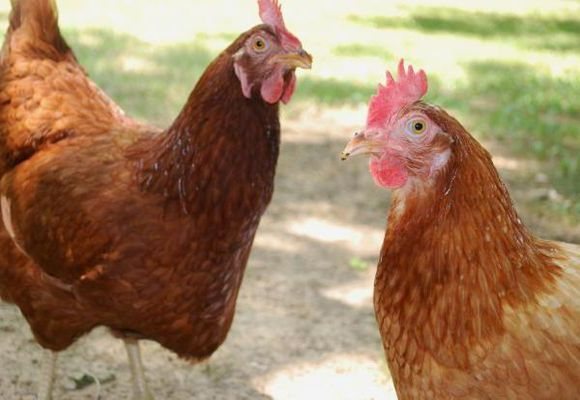

This information suggests that the Hisex Brown chicken breed is highly productive and pays off quickly. Currently, Hisex Brown is one of the most common and profitable breeds among home and poultry owners.
Individuals do not require a large amount of compound feed, however, they give excellent productivity results.
Gender distribution
Before hatching
It is possible to determine the sex of highsex chicks even before they are born. In industrial plants, the most accurate result is established using an ovoscope.
Determination of sex by ovoscopic method is carried out in the first week before the start of incubation.


The principle of operation of the ovoscope is to shine through the contents of the egg with halogen bulbs. In the first week, the air chamber is clearly visible. If it is located strictly in the center of the egg, then there is a male inside. If it is slightly shifted to one of the edges, a female is inside.
In addition, the sex of highsex chicks is determined by the shape and surface of the egg. It is believed that from eggs with a sharper end and a bumpy surface, cockerels appear.
After hatching
After the appearance of chickens on an industrial scale, a cytogenetic method of determination is used - DNA analysis.
At home, sex determination in newly hatched highsex chicks is possible according to a number of signs:
- the cock weighs 2-3 grams more;
- the paws of the cockerels are widely spaced;
- the color of the wings of males is lighter (this feature is distinguishable on day 3);
- feathering of the wing in chickens is more active;
- feathers in females are of different lengths, in cockerels - uniform.
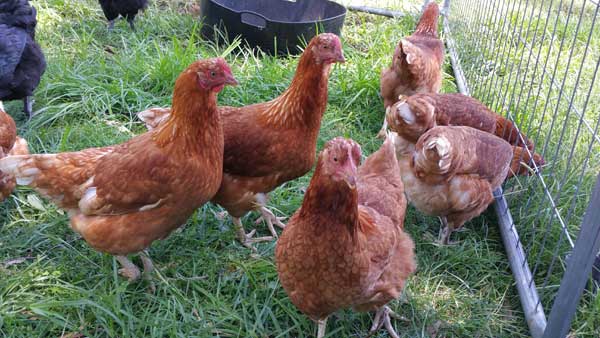

Advantages and disadvantages of a hybrid
The advantages of this cross include:
- High rates of egg production, which do not depend on the season.
- Chicks have high survival rates, up to 95%.
- Hisex Brown have good immunity, which protects the bird not only from diseases, but also from parasite attacks.
- This is a fairly unpretentious cross in care.
- Relatively well and painlessly tolerates low temperatures.
- A completely independent bird that can easily find food in the backyard, which makes keeping chickens more economical.
- In favorable conditions, chickens can give their first clutch as early as 4 months of age.
Recently, Hisex Brown began to be bred more and more at home (previously industrial cultivation prevailed).This is because more productive hybrids have appeared on the market, which show greater profitability in industrial growing conditions.
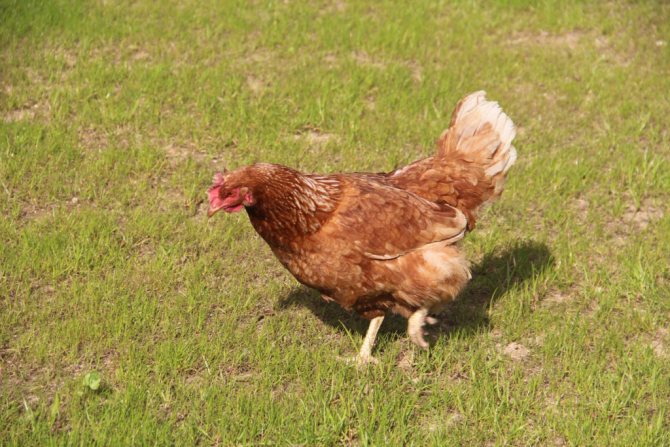

Does cross have any disadvantages? Yes, like any other breed or hybrid. The main disadvantages of Hisex Brown include:
- Very weak maternal instinct. Hisex chickens do not incubate eggs, and if they are going to do this, they very rarely sit to the end. For this reason, you have to either purchase chickens on the market, or increase the family yourself, using incubators.
- In order for chickens to show peak egg production, they must be fed with high-quality feed.
- Highsex meat is of very poor quality.
- If you keep crosses in a confined space, then they can show excessive loudness and become quite aggressive (especially for the white variety of Hysex).
- This hybrid does not always immediately adapt to a new place of life and host.
Possible diseases, symptoms and prevention methods
Highsex white or brown chickens rarely get sick. Mainly due to non-compliance with sanitary and hygienic requirements and poor care.
Common symptoms of diseases:
- weakness;
- passivity;
- refusal to eat;
- weight loss;
- hard breath;
- cramping;
- wheezing of the airways;
- prolonged loose stools.
A sick bird is isolated in a separate room. Do not neglect your own safety measures: use gloves, wash your hands with soap and water. To determine the diagnosis, it is better to consult a specialist.
Almost all diseases of highsex chickens are treated with antibiotics. The drugs can be purchased at the pharmacy, veterinary clinic, pet store.


To prevent chickens from getting sick, regular preventive measures are necessary: cleaning in the hen house and paddock, periodically changing the litter, ensuring clean drinking, adhering to the rules for compiling a diet, adding mineral and vitamin supplements, vaccination strictly on schedule.




